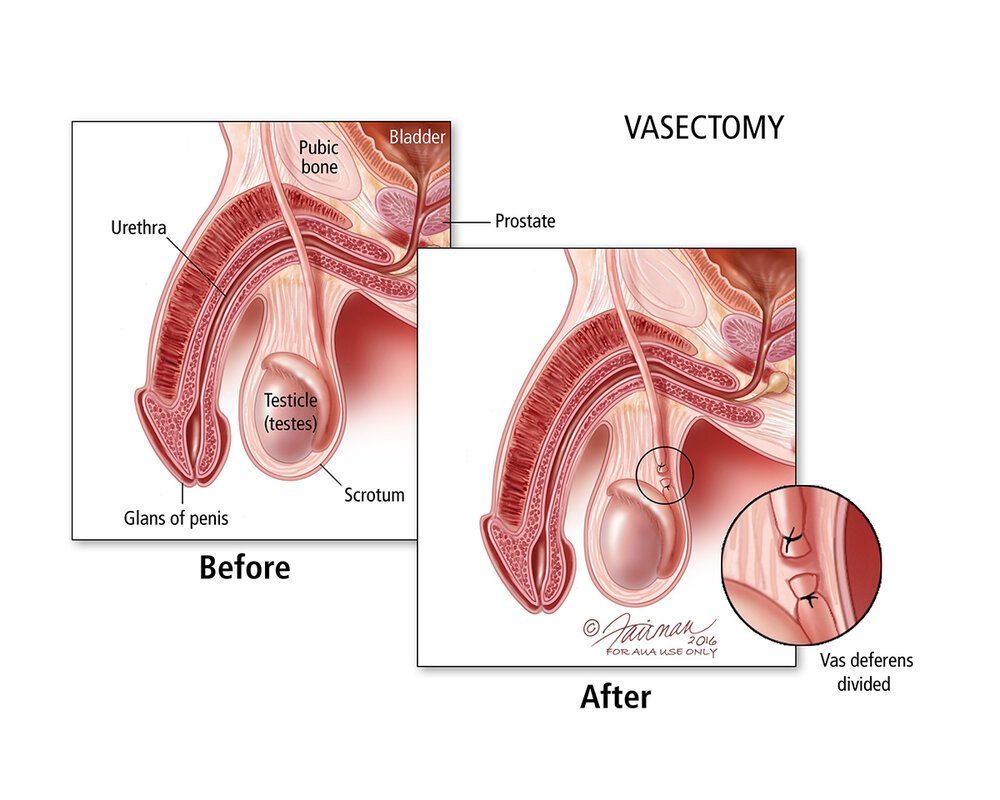No Scalpel Vasectomy
NO SCALPEL VASECTOMY TREATMENT
Vasectomy is a minor surgery to block sperm from reaching the semen that is ejaculated from the penis. Semen still exists, but it has no sperm in it. After a vasectomy the testes still make sperm, but they are soaked up by the body. Each year, more than 500,000 men in the U.S. choose vasectomy for birth control. A vasectomy prevents pregnancy better than any other method of birth control, except abstinence.

Vasectomies are done in the office. In the procedure room, your scrotal area will be shaved and washed with an antiseptic solution. Local anesthesia will be injected to numb the area, but you'll be aware of touch, tension, and movement. The local anesthetic should block any sharp pain. If you feel pain during the procedure, you can let your urologist know so you can get more anesthesia.
For a no-scalpel vasectomy, the urologist feels for the vas under the skin of the scrotum and holds it in place with a small clamp. A tiny hole is made in the skin and stretched open so the vas deferens can be gently lifted out. It is then cut, tied or seared, and put back in place. The entire procedure takes about 20 minutes with minimal discomfort.
What are the Risks?
Right after surgery, there’s a small risk of bleeding into the scrotum. If you notice that your scrotum has gotten much bigger or you are in pain, call your urologist right away. If you have a fever, or your scrotum is red or sore, you should have your urologist check for infection. There is a small risk for post-vasectomy pain syndrome. This occurs in 1 or 2 men out of 100 vasectomies. Post-vasectomy pain syndrome is a pain that can follow a vasectomy. It isn’t clear what causes this in many cases, but it’s most often treated with anti-swelling meds. If this occurs, see your urologist as sometimes the specific cause can be treated with medicine or a minor procedure.
Studies show men who have had a vasectomy are not at a higher risk for any other medical conditions such as heart disease, prostate cancer, testicular cancer, or other health problems.
RECOVERY
After your vasectomy, you may be uncomfortable for a few days. To reduce your pain, you may need mild pain medication to take care of any pain. Severe pain may suggest infection or other problems and you should see your urologist. You may have mild pain like what you'd feel like several minutes after getting hit "down there." A benign lump (granuloma) may form from sperm leaking from the cut end of the vas into the scrotal tissues. It may be painful or sensitive to touch or pressure, but it isn't harmful. Most of the time, you don’t feel pain and this usually gets better with time.
Your urologist will give you instructions for care after a vasectomy. Most men go home right away after the procedure. You should avoid sex for 3-7 days or activities that take a lot of strength. Swelling and pain can be treated with an ice pack on the scrotum and wearing a supportive undergarment, such as a jockstrap. Most men fully heal in less than a week. Many men are able to return to their job as early as the next day if they do desk work.
Sex can often be resumed within a week after the vasectomy, but it's important to know that a vasectomy doesn't work right away. After the vasectomy, new sperm won't be able to get into the semen, but there will still be lots of sperm "in the pipeline" that takes time to clear. You should follow up with your urologist for semen analysis to check for sperm in your ejaculate. During this time, you should use other forms of birth control.
The time it takes for your ejaculate to be free of sperm can differ. Most urologists suggest waiting to check the semen for at least 3 months and/or 20 ejaculates. One in 100 men will still have sperm in their ejaculate at that time and may need to wait longer for the sperm to clear. You shouldn't assume that your vasectomy is effective until a semen analysis proves it is.
FREQUENTLY ASKED QUESTIONS
-
Can my partner tell if I have had a vasectomy?
Sperm adds very little to the semen volume, so you shouldn't notice any change in your ejaculate after vasectomy. Your partner may sometimes be able to feel the vasectomy site. This is particularly true if you have developed a granuloma.
-
Will my sense of orgasm be changed by having a vasectomy?
Ejaculation and orgasm are not affected by vasectomy. The special case is the rare man who has developed post-vasectomy pain syndrome.
-
Can I develop erectile dysfunction after a vasectomy?
A vasectomy does not cause erectile dysfunction.Clinical studies have shown the UroLift® System treatment does not cause new, sustained instances of erectile or ejaculatory dysfunction1. The same cannot always be said of other BPH therapies such as TURP, laser, and even medication.After the treatment, patients typically go home the same day without a catheter. There is minimal downtime post- treatment and many patients experience symptom relief in as early as 2 weeks. Patients may experience some urinary discomfort during the recovery period. Most common side effects are mild to moderate and include pain or burning with urination, blood in the urine, pelvic pain, urgent need to urinate and/or the inability to control the urge. Most symptoms resolved within two to four weeks after the procedure.
-
Can a vasectomy fail?
There is a small chance a vasectomy may fail. This occurs when sperm leaking from one end of the cut vas deferens find a channel to the other cut end. Once your urologist clears you with a sperm test showing no sperm or less than 100,000 sperm, with none moving, the risk of pregnancy is 1 in 2000.
-
Can something happen to my testicles?
In rare cases, the testicular artery may be hurt during vasectomy. Other problems, such as a mass of blood (hematoma) or infection, may also affect the testicles.
-
Can I have children after my vasectomy?
Describe the item or answer the question so that site visitors who are interested get more information. You can emphasize this text with bullets, italics or bold, and add links.
All Rights Reserved | Site by Fix8

